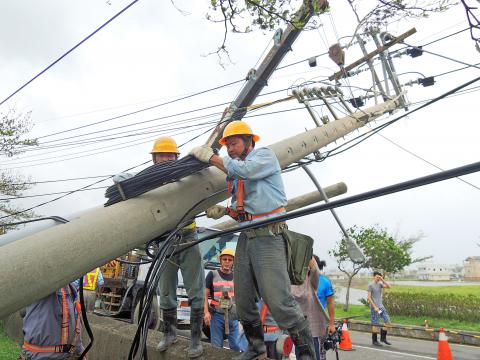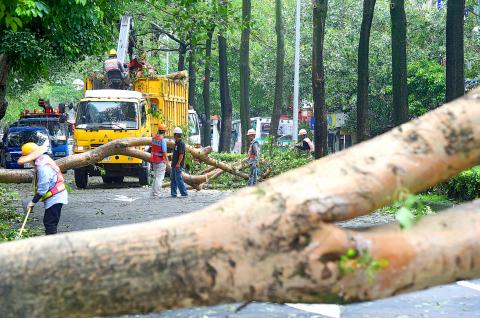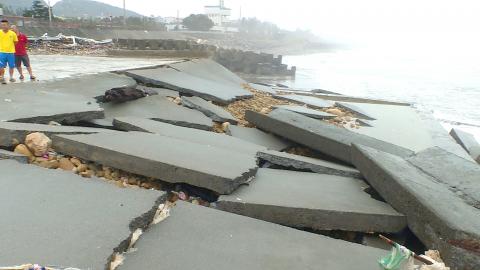Three people died and 376 were injured as Typhoon Dujuan pummeled the nation with torrential rainfall and strong winds, the Central Emergency Operation Center said yesterday.
Among the three people killed was a 70-year-old man in New Taipei City’s Tucheng District (土城), who fell to the ground and died after being blown over by a gust of wind.
A 54-year-old worker in Taichung was flung into the air by strong winds as he stood on a corrugated steel sheet on a fence near a construction site.

Photo: Chiang Chih-hsiung, Taipei Times
He died after falling from a height of about 3m.
The third person killed was a 41-year-old woman surnamed Yu (余), who died after sustaining serious injuries in a car accident during the storm.
By 8am yesterday, about 12,000 people had been evacuated, the center said.

Photo: Chien Jung-fong, Taipei Times
The typhoon disrupted water and power supplies in northern Taiwan.
Data from Taiwan Power Co (Taipower) showed that electricity was not available for more than 2.27 million households at one point.
Taipower said that by 6:30pm yesterday, 119,048 households had yet to regain power supplies.

Photo: CNA
Taiwan Water Corp suspended the water supply to almost 150,000 households and reduced water pressure to 145,200 households over high river turbidity.
The water company said normal water supply would resume completely by 6am today.
The nation’s main transportation systems had largely resumed normal operations yesterday.
Taiwan High Speed Rail Corp began train operations at 11:30am yesterday from Taipei, Taichung, Tainan and Kaohsiung high-speed rail stations to facilitate the transportation of passengers, many of whom are to return to work today,
The Taiwan Railways Administration (TRA) reported severe damage to the North Link Railway and resumed services nationwide by 6pm yesterday, although trains could only operate on one set of tracks in some sections.
Taiwan Taoyuan International Airport estimated that about 126,000 passengers accessed the airport yesterday as airlines resumed flights, with passengers beginning to line up at check-in counters as early as 4:30am.
Though the Central Weather Bureau had not lifted sea and land alerts by 5:30pm yesterday, the wind and rain brought by Dujuan had largely eased by early yesterday morning.
The Ministry of Transportation and Communications apologized to the public for crowds in railway stations on Monday, which was the last day of the Mid-Autumn Festival holiday.
Deputy Minister Tseng Dar-jen (曾大仁) said the ministry would henceforth activate emergency transport plans as soon as a land alert for a typhoon is announced during a major national holiday.
When the occurrence of a typhoon coincides with any of the nation’s major holidays, alternative transportation methods would be arranged for the high-speed rail system, TRA systems, then buses, in that order, Tseng said.
People would be given maximum flexibility if they ask for a refund or to exchange for train tickets departing on other days given the extenuating circumstances, Tseng added.
The high-speed rail system transported 180,000 passengers between 6am and 3pm on Monday, Tseng said.
In the past, the system could transport up to 240,000 passengers per day.

AIR SUPPORT: The Ministry of National Defense thanked the US for the delivery, adding that it was an indicator of the White House’s commitment to the Taiwan Relations Act Deputy Minister of National Defense Po Horng-huei (柏鴻輝) and Representative to the US Alexander Yui on Friday attended a delivery ceremony for the first of Taiwan’s long-awaited 66 F-16C/D Block 70 jets at a Lockheed Martin Corp factory in Greenville, South Carolina. “We are so proud to be the global home of the F-16 and to support Taiwan’s air defense capabilities,” US Representative William Timmons wrote on X, alongside a photograph of Taiwanese and US officials at the event. The F-16C/D Block 70 jets Taiwan ordered have the same capabilities as aircraft that had been upgraded to F-16Vs. The batch of Lockheed Martin

GRIDLOCK: The National Fire Agency’s Special Search and Rescue team is on standby to travel to the countries to help out with the rescue effort A powerful earthquake rocked Myanmar and neighboring Thailand yesterday, killing at least three people in Bangkok and burying dozens when a high-rise building under construction collapsed. Footage shared on social media from Myanmar’s second-largest city showed widespread destruction, raising fears that many were trapped under the rubble or killed. The magnitude 7.7 earthquake, with an epicenter near Mandalay in Myanmar, struck at midday and was followed by a strong magnitude 6.4 aftershock. The extent of death, injury and destruction — especially in Myanmar, which is embroiled in a civil war and where information is tightly controlled at the best of times —

China's military today said it began joint army, navy and rocket force exercises around Taiwan to "serve as a stern warning and powerful deterrent against Taiwanese independence," calling President William Lai (賴清德) a "parasite." The exercises come after Lai called Beijing a "foreign hostile force" last month. More than 10 Chinese military ships approached close to Taiwan's 24 nautical mile (44.4km) contiguous zone this morning and Taiwan sent its own warships to respond, two senior Taiwanese officials said. Taiwan has not yet detected any live fire by the Chinese military so far, one of the officials said. The drills took place after US Secretary

THUGGISH BEHAVIOR: Encouraging people to report independence supporters is another intimidation tactic that threatens cross-strait peace, the state department said China setting up an online system for reporting “Taiwanese independence” advocates is an “irresponsible and reprehensible” act, a US government spokesperson said on Friday. “China’s call for private individuals to report on alleged ‘persecution or suppression’ by supposed ‘Taiwan independence henchmen and accomplices’ is irresponsible and reprehensible,” an unnamed US Department of State spokesperson told the Central News Agency in an e-mail. The move is part of Beijing’s “intimidation campaign” against Taiwan and its supporters, and is “threatening free speech around the world, destabilizing the Indo-Pacific region, and deliberately eroding the cross-strait status quo,” the spokesperson said. The Chinese Communist Party’s “threats